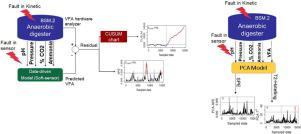Process Safety and Environmental Protection ( IF 6.9 ) Pub Date : 2020-12-24 , DOI: 10.1016/j.psep.2020.12.016 Pezhman Kazemi , Christophe Bengoa , Jean-Philippe Steyer , Jaume Giralt

|
Anaerobic digestion (AD) is an appropriate process for bio-energy (biogas) production from waste and wastewater receiving a high level of attention at both academic and industrial scale due to increasing public awareness regarding environmental protection and energy security. Monitoring such processes is an imperative task to ensure optimized operation and prevent failures and serious consequences during the operation of the plant. To fulfill this task, a practical data-driven framework for fault detection in AD is proposed and validated on a simulated data set obtained using the benchmark simulation model No.2 (BSM2) from the International Water Association (IWA). The proposed framework is based on data-driven soft-sensors predicting total volatile fatty acids (VFA), mainly consisting of acetate, propionate, valerate and butyrate concentrations inside the digester. The VFA concentration is considered because it does not only reflect the current process health, but it is also sensitive to the incoming feeding imbalances. VFA soft-sensors using different advanced techniques such as support vector machine (SVM), extreme learning machine (ELM) and ensemble of neural network (ENN) are tested and compared in terms of accuracy and fault detection (FD) robustness. A principal component analysis (PCA) model was also developed to compare the proposed approaches with the traditional FD method. By applying soft-sensors, the residual signal, i.e., the difference between estimated and measured VFA values can be generated. This residual signal can then be used in combination with univariate statistical control charts to detect the faults. A comparison of the proposed FD framework with PCA method clearly demonstrates the over performance and feasibility of the proposed monitoring framework.
中文翻译:

数据驱动技术在厌氧消化过程中的故障检测
由于公众对环境保护和能源安全的意识增强,厌氧消化(AD)是一种从废物和废水中生产生物能源(沼气)的合适方法,在学术和工业领域都受到了高度关注。监视此类过程是一项当务之急,以确保优化运行并防止工厂运行期间出现故障和严重后果。为了完成此任务,提出了一种实用的数据驱动的AD故障检测框架,并在使用国际水协会(IWA)的基准模拟模型2(BSM2)获得的模拟数据集上进行了验证。拟议框架基于数据驱动的软传感器,可预测总挥发性脂肪酸(VFA),主要包括乙酸盐,丙酸盐,消化池中的戊酸和丁酸浓度。考虑VFA浓度是因为它不仅反映了当前过程的健康状况,而且对传入的进料失衡也很敏感。使用不同的先进技术(例如支持向量机(SVM),极限学习机(ELM)和神经网络集成(ENN))对VFA软传感器进行了测试,并就准确性和故障检测(FD)的鲁棒性进行了比较。还开发了主成分分析(PCA)模型,以将建议的方法与传统的FD方法进行比较。通过应用软传感器,可以生成残余信号,即,估计的和测量的VFA值之间的差。然后可以将此残差信号与单变量统计控制图结合使用以检测故障。











































 京公网安备 11010802027423号
京公网安备 11010802027423号